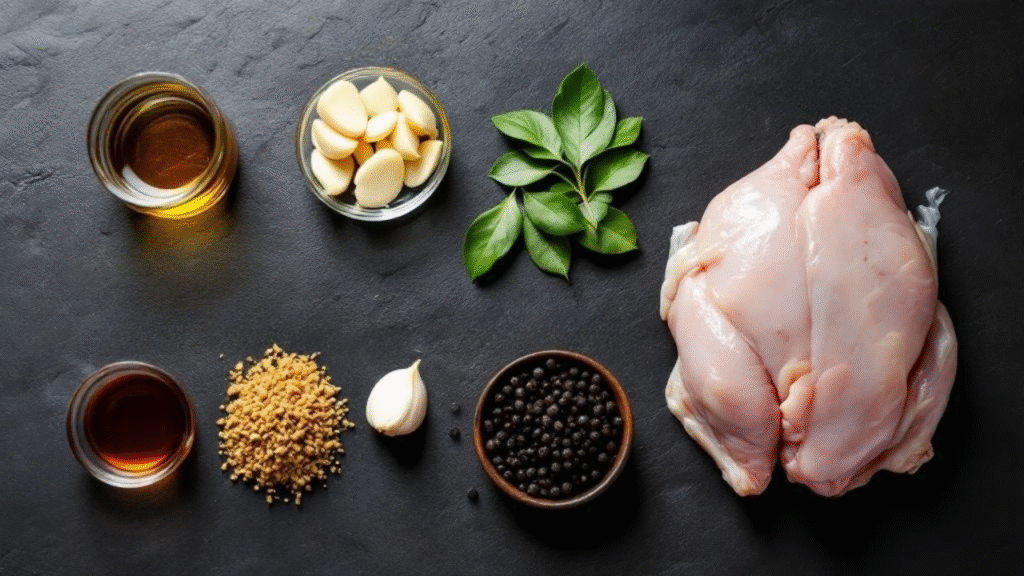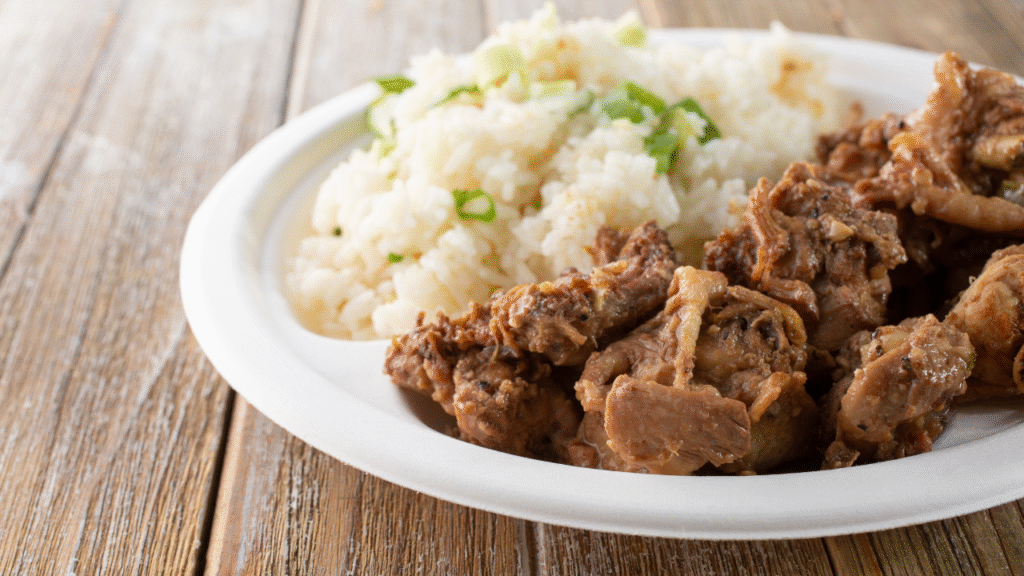What if one dish could connect Spanish sailors, Filipino households, and global food lovers? Adobo, with its bold, tangy punch and comforting aroma, is more than just a recipe; it’s a living story. A story told through vinegar, garlic, soy sauce, and the generations of cooks who’ve adapted it, shared it, and made it their own.
To some, Adobo is a rich stew of braised chicken or pork, simmered in a savory, tangy sauce that clings to every bite. To others, it’s a smoky spice blend used to marinate meats in Mexico or the Caribbean, such as Puerto Rico.
And for millions of Filipinos around the world, it’s home on a plate—served over rice, packed into lunchboxes, and cooked with pride. The name may be the same, but Adobo means different things to different cultures, each interpretation shaped by history, geography, and necessity.
So what exactly is Adobo? How did a technique for preserving meat become a global culinary icon? And why does this dish—built on humble pantry staples—continue to capture hearts (and appetites) across continents?
In this article, we’ll explore the fascinating origins of Adobo, its evolution across cultures, the science behind its addictive flavor, and why it remains one of the world’s most beloved and adaptable dishes.
🍽️What Is Adobo, Really?
At first glance, “adobo” might seem like a single dish. But dig deeper, and you’ll discover it’s actually a term with multiple identities—each rooted in different culinary traditions.
Filipino Adobo: A Technique, Not Just a Recipe
In the Philippines, Adobo isn’t one fixed dish—it’s a cooking method. At its core, Filipino Adobo involves braising meat (often chicken or pork) in a mixture of vinegar, garlic, soy sauce, bay leaves, and black peppercorns.
The result is a deeply savory, slightly tangy stew with a glossy, aromatic sauce that clings to every bite. It’s flexible, too—home cooks might swap in coconut milk, add chilies, or use fish, tofu, or vegetables depending on what’s on hand.
What makes it Filipino Adobo is not just the ingredients, but the balance of acid, salt, and umami, as well as the distinctive use of vinegar as both a flavor and a preservative—a tradition that dates back long before the advent of refrigeration.
Spanish and Latin American Adobo: A Flavorful Marinade
Travel across the globe to Spain or Latin America, and “adobo” takes on a different meaning. In these regions, Adobo typically refers to a spiced marinade or paste—often made from paprika, garlic, oregano, vinegar, and other herbs and spices. It’s rubbed onto meats, seafood, or vegetables to infuse them with flavor before cooking.
In Mexico, Adobo is used as a red chili paste for marinating pork or flavoring sauces. In Puerto Rico and the Caribbean, Adobo can refer to either a dry seasoning mix or a wet marinade, both of which are used to prepare meats with bold, earthy flavors.
One Name, Many Meanings: How Did That Happen?
The shared name isn’t a coincidence—it’s a result of colonial exchange and adaptation.
When Spanish colonizers arrived in the Philippines in the 16th century, they encountered local dishes that used vinegar and salt to preserve food in the tropical climate. The Spanish recognized this as similar to their own “adobo” marinades and gave the native dish a familiar name. But instead of changing the local method, they simply rebranded it using a Spanish term—and over time, the Filipino version evolved into its unique tradition.
So, while both Filipino and Spanish/Latin American adobos involve vinegar and garlic, they come from different culinary lineages, each shaped by its region’s flavors, climate, and culture.
| Feature | Filipino Adobo | Latin American Adobo |
|---|---|---|
| Definition | Braising method | Marinade or spice blend |
| Main Ingredients | Vinegar, soy sauce, garlic, bay leaves, and meat | Vinegar, chilies, paprika, oregano, garlic |
| Common Forms | Stew-like (chicken/pork over rice) | Rubs, sauces, and marinades for grilled or roasted meats |
| Cultural Origin | Indigenous Filipino technique | Spanish & Latin American cooking tradition |
🍗Filipino Adobo – The National Dish Born of Necessity

Before Filipino Adobo became a symbol of national pride, it was a solution to a tropical problem: how to keep food from spoiling in a hot, humid climate. Long before refrigeration, Filipino cooks developed a smart method of preserving meat using vinegar, salt, and heat. The result wasn’t just practical—it was delicious.
A Pre-Colonial Technique with Deep Roots
Long before Spanish contact, indigenous Filipinos were already stewing meats and seafood in vinegar and salt—natural preservatives that kept food safe in the heat and humid air. Garlic, often used to ward off spoilage and enhance flavor, became a natural part of the mix. This early version of Adobo was less about seasoning and more about survival.
Spanish Influence, Filipino Identity
When the Spanish arrived in the 1500s, they saw a familiar process. In Spain, “adobo” referred to marinating food in vinegar and spices, usually before cooking or preserving. The colonizers applied the term to the local dish they encountered, even though the technique had different origins. Over time, soy sauce (introduced via Chinese trade) and other influences crept into the mix, creating the Adobo we recognize today.
But make no mistake—Filipino Adobo isn’t a Spanish transplant. It’s an indigenous cooking method wrapped in a borrowed name, layered with foreign influences, and perfected in Filipino kitchens over centuries.
A Dish That’s Always Evolving
Part of what makes Filipino Adobo so beloved is its flexibility. There’s no one “authentic” recipe; each household has its variation. Some go heavy on the garlic. Others add sugar, coconut milk, or chilies. The protein can be anything from chicken (adobong manok) to pork (adobong baboy) to squid (adobong pusit) or even vegetables and tofu.
Despite these differences, all versions share one thing: that signature tangy-salty depth that’s unmistakably Adobo.
| 🧂 Ingredient | 🍽️ Purpose in the Dish |
|---|---|
| 🧄 Garlic | Adds depth, aroma, and subtle sweetness |
| 🫙 Vinegar | Provides tanginess and helps preserve the meat |
| 🧂 Soy Sauce | Adds saltiness, umami, and rich color |
| 🍗 Chicken or Pork | The main protein—braises and absorbs flavor |
| 🌿 Bay Leaves | Infuse the dish with mild herbal notes |
| ⚫ Whole Peppercorns | Add a gentle bite and earthy heat |
More Than a Dish—A Cultural Touchstone
Adobo has earned its place as the unofficial national dish of the Philippines, not just for its taste, but for what it represents: resilience, adaptability, and heritage. It’s comfort food, party food, everyday food—and a point of pride for Filipinos at home and abroad.
🌍How Adobo Traveled the World
Adobo may have started as a humble dish in Filipino kitchens, but its flavor and story have crossed oceans. Thanks to migration, colonization, and cultural exchange, Adobo now exists in many forms across the globe—each one a reflection of local tastes and culinary traditions.
Spanish Roots and Colonial Routes
The word “Adobo” itself originated from the Spanish verb “adobar,” meaning “to marinate” or “to season.” As Spanish explorers and colonizers journeyed across Latin America and the Philippines, they introduced the concept of Adobo, but its manifestation depended on local ingredients, customs, and climate.
In the Philippines, the Spanish name stuck, but the dish remained rooted in pre-colonial preservation methods. In contrast, across Mexico, Peru, and the Caribbean, Adobo evolved into spice-heavy marinades and rubs, using local chilies, herbs, and native cooking styles.
Adobo Across Latin America
In Mexico, Adobo refers to rich chili pastes made from dried peppers, such as guajillo or ancho, blended with garlic, vinegar, and spices. These pastes are used to marinate pork (as in adobada) or enrich stews and sauces.
In Puerto Rico and the Dominican Republic, Adobo often means a dry seasoning mix of garlic powder, oregano, salt, pepper, and sometimes citrus zest—a pantry staple used to season meats before frying or grilling.
These versions may share a name, but they’re fundamentally different from Filipino Adobo in both technique and taste.
The Filipino Diaspora and Global Popularity
As Filipino communities grew across the U.S., Canada, the Middle East, and beyond, so did the craving for Adobo. Home cooks recreated the dish abroad, sometimes adjusting ingredients based on availability, swapping palm vinegar for white vinegar, or adding new twists like brown sugar or coconut milk for a creamier finish.
Today, you’ll find Filipino Adobo on restaurant menus in New York, London, Los Angeles, and Sydney, featured in cookbooks by Filipino chefs, and shared in viral YouTube videos and TikToks. Its flavor is approachable, its method is simple, and its story resonates—making it the perfect ambassador of Filipino cuisine.
A Dish That Adapts and Endures
No matter where it lands, Adobo adapts. That’s the beauty of it. Whether it’s spooned over rice in a Filipino home, used as a marinade in a Latin American grill, or reinvented in a fusion dish by a modern chef, Adobo reflects how food travels, evolves, and connects us.
🔬Why We Love It – The Flavor Science Behind Adobo

What makes Adobo so craveable? Why does that first bite feel like a comforting hug, and the last bite leave you wanting more? The answer lies not just in culture, but in chemistry.
A Symphony of Taste
Adobo is a masterclass in balanced flavor. At its core, it brings together the five basic tastes:
- Sour – from vinegar
- Salty – from soy sauce or salt
- Umami – from browned meat, soy sauce, and garlic
- Sweet – optional, but often added to round out the acidity
- Bitter – from peppercorns or bay leaves (subtle but present)
This harmony keeps your palate engaged. The tang of vinegar brightens each bite, while the savory depth of soy sauce and garlic grounds the dish. If sugar is added, it adds balance and softens sharpness, creating a bold but never overwhelming flavor profile.
The Maillard Reaction Magic
Suppose you sear your meat before braising (a common technique in many Filipino households). In that case, you’re unlocking another layer of flavor through the Maillard reaction—the browning of proteins that adds a rich, meaty complexity. It’s the same magic that makes toasted bread, grilled steak, or roasted coffee so irresistible.
Combined with the slow simmer in vinegar and spices, this creates a sauce that’s rich, glossy, and layered, coating each piece of meat in a glaze that clings just right.
Vinegar: The Secret Star
Vinegar isn’t just a flavoring—it’s a preservative, tenderizer, and flavor enhancer. It breaks down proteins gently, resulting in fork-tender meat. It also brightens the entire dish, cutting through fat and adding a mouthwatering sharpness that makes Adobo so unique.
Not all vinegars are created equal, either. Filipino Adobo often uses cane vinegar, but in modern kitchens, you’ll find a range of options, including white vinegar, apple cider, and even balsamic vinegar. Each one adds its character.
Comfort Meets Complexity
Despite its short ingredient list, Adobo tastes complex—and that’s part of its charm. It feels familiar but also exciting. There’s no single dominant flavor. Instead, each bite offers a balance of comfort, tang, warmth, and depth.
That’s the science—and the soul—of why Adobo is a dish that people return to again and again.
| Flavor Element | Source | Effect on Dish |
|---|---|---|
| Sour | Vinegar | Brightness, preservation |
| Salty | Soy sauce or salt | Depth, umami boost |
| Umami | Browning meat, soy, and garlic | Savory richness |
| Sweet (optional) | Sugar, caramelization | Balances acidity |
| Bitter (subtle) | Bay leaves, peppercorns | Rounds out the flavor |
💡Common Mistakes & How to Fix Them

Adobo is known for being simple and forgiving—but even the easiest dishes have their pitfalls. Whether you’re new to Filipino cooking or just want to perfect your technique, here are the most common adobo mistakes—and how to avoid them.
❌ Mistake 1: Using the Wrong Type (or Too Much) Vinegar
The fix: Stick to a mild, clean vinegar, such as cane, rice, or white vinegar. Stronger types, such as balsamic or malt, can overpower the dish or muddy the flavor. Also, don’t go overboard. Too much vinegar makes the sauce too sharp. Aim for balance, not a puckered mouth.
❌ Mistake 2: Skipping the Browning Step
The fix: Searing the meat before braising adds depth and flavor. It’s where the Maillard reaction happens, giving you rich, savory flavor and a more appetizing color. Take a few extra minutes to brown your meat well—it’s worth it.
❌ Mistake 3: Not Simmering Long Enough
The fix: Adobo needs time for the flavors to meld and the sauce to reduce in intensity. Rushing it can lead to a watery or unbalanced dish. Let it simmer gently until the meat is tender and the sauce coats the back of a spoon.
❌ Mistake 4: Using Low-Quality Soy Sauce
The fix: Soy sauce is one of Adobo’s primary flavoring agents, so quality is crucial. Use a naturally brewed soy sauce (like Kikkoman or Silver Swan). Avoid overly salty or artificial-tasting brands that throw off the flavor balance.
❌ Mistake 5: Not Tasting and Adjusting
The fix: Don’t treat Adobo like a set-it-and-forget-it dish. Taste the sauce toward the end. If it’s too salty, add a splash of water or more vinegar to adjust the flavor. Too sour? A pinch of sugar can mellow it out. Your palate is your best tool.
❌ Mistake 6: Throwing everything in at Once
The fix: Layering flavors makes a big difference. Sauté garlic first to mellow its bite. Brown the meat. Add vinegar last and resist stirring right away—this helps preserve its tang and prevents bitterness from developing.
✅ Quick Tips for Adobo Success:
- Let it rest: Adobo often tastes better the next day.
- Use a wide pan: It helps the sauce reduce evenly.
- Try a mix of chicken and pork for added texture and flavor.
- Add a bay leaf or two for a subtle aroma—but don’t overdo it.
🎬Adobo in Pop Culture & Modern Cuisine

Adobo isn’t just simmering on stovetops anymore—it’s making waves in restaurants, cookbooks, YouTube channels, and food shows worldwide. What started as a home-cooked staple has become a global culinary icon, embraced by both traditionalists and modern chefs alike.
From Home Kitchens to Headlines
Across Filipino households, Adobo remains a classic comfort food, served over hot rice, packed into lunchboxes, or lovingly prepared for family gatherings. But today, it’s also stepping into the spotlight, thanks in part to the growing interest in Filipino cuisine around the world.
Adobo has been featured on shows like Top Chef, highlighted in publications such as Bon Appétit and The New York Times Cooking, and celebrated by Filipino chefs like Cristina Quackenbush, Charles Olalia, and Melissa Miranda, who are bringing traditional flavors into modern kitchens.
Creative Twists and Fusion Spins
Chefs and food creators are also having fun with Adobo, reimagining it in ways that feel both fresh and familiar. You’ll now find:
- Adobo tacos with pickled onions and cilantro
- Adobo pulled pork sliders at food trucks
- Adobo fried rice topped with a sunny-side egg
- Adobo chicken wings with spicy glaze
- Even adobo-inspired ramen and pasta
These riffs aren’t about erasing tradition—they’re about honoring it through innovation, demonstrating how a humble dish can evolve while still retaining its soul.
The Rise of Filipino Food Representation
For many Filipino Americans and members of the diaspora, Adobo isn’t just a meal—it’s a cultural bridge. Sharing adobo recipes on YouTube or Instagram becomes a way to celebrate identity, pass down heritage, and introduce the world to the rich flavors of Filipino cuisine.
Social media has amplified this movement. Search #adobo on TikTok or Instagram, and you’ll find countless variations—from beginner-friendly tutorials to family recipes passed down for generations. It’s not just trending—it’s connecting generations and communities through food.
📝Conclusion – More Than a Meal

Adobo is more than a recipe—it’s a reflection of history, heritage, and heart. It tells the story of how simple ingredients can travel across continents, adapt to new homes, and still hold on to their essence.
From its roots as a preservation method in pre-colonial Philippines to its reinvention under Spanish influence, and its modern interpretations in global kitchens, Adobo proves that great food doesn’t need to be complicated—it just needs roots. It’s a dish that welcomes variation, embraces creativity, and never forgets its roots.
Whether you grew up with the scent of vinegar and garlic wafting from your family kitchen, or you’re just discovering Adobo for the first time, one thing is clear: this tangy favorite has earned its place at tables around the world—not just for its flavor, but for the stories it carries in every bite.
The next time you make or savor Adobo, know that you’re not just enjoying a comforting meal—you’re participating in a global tradition that continues to evolve, inspire, and unite people.
Thanks for reading!
If you enjoyed this article, be sure to follow us on social media and subscribe to the blog for more crave-worthy recipes, smart kitchen tips, and culinary deep dives.
Let’s keep cooking something amazing—together.
🙋Frequently Asked Questions About Adobo

❓ What is Adobo, and how does the term differ across cultures?
Adobo means different things depending on the region. In the Philippines, it’s a method of braising meat in a mixture of vinegar, soy sauce, garlic, and spices to create a tangy, savory stew. In places like Mexico or Puerto Rico, “adobo” refers to a marinade or seasoning mix, often made with chilies, paprika, and herbs.
❓ How did Filipino Adobo originate, and what role did necessity play in its development?
Filipino Adobo originated as a method to preserve food in a hot climate, utilizing vinegar and salt to prevent spoilage. Garlic added flavor and more preservative power. The Spanish later gave this local method the name “adobo,” but the technique itself is purely Filipino in origin.
❓ How did the Spanish influence the name “Adobo” in the Philippines, and how does this reflect cultural exchange?
When the Spanish arrived, they saw Filipinos stewing meat in vinegar and salt—a process similar to their marinades. Rather than change it, they simply called it “adobo,” applying a familiar name to a native method. It’s a classic case of colonial naming, not culinary replacement.
❓ Why is Filipino Adobo considered a flexible and evolving dish, rather than having one fixed recipe?
Adobo isn’t one recipe—it’s a technique that adapts to various ingredients. Every family has their version, using different meats, adding coconut milk, or sweetening it slightly. That flexibility is what’s kept it alive and beloved across generations.
❓ What are the key flavor components that make Adobo so appealing, and what “flavor science” is at play?
Adobo hits all five basic tastes—sour, salty, umami, sweet, and a little bitter—creating a balanced, craveable dish. Browning the meat adds rich, savory depth (thanks to the Maillard reaction), while vinegar helps tenderize and brighten everything. It’s comfort food with serious flavor chemistry.
❓ What are some common mistakes home cooks make when preparing Adobo, and how can they be avoided?
Mistakes include using too much vinegar, skipping the browning step, and not simmering long enough. Use mild vinegar and good soy sauce, and let the dish sit for a while to reduce and develop flavor. Always taste and adjust at the end for balance.
❓ How has Adobo transitioned from a humble home-cooked dish to a global culinary icon?
Filipino migrants brought Adobo around the world, adapting it along the way. Now it’s found in restaurants, cookbooks, food shows, and TikToks—sometimes reinvented as tacos or rice bowls. Its flavor, simplicity, and cultural story made it a global hit.
❓ What does Adobo represent beyond just a meal for Filipinos?
Adobo is more than food—it’s identity, memory, and home. For many Filipinos, it symbolizes resilience and tradition, passed down through generations. Sharing it with others is a way to celebrate heritage and connect through flavor.




